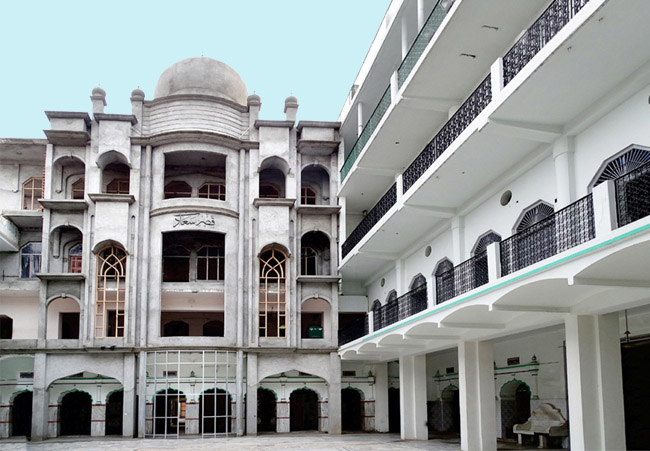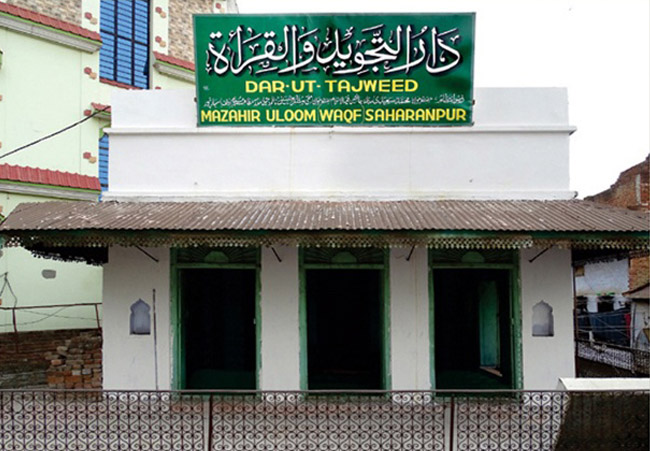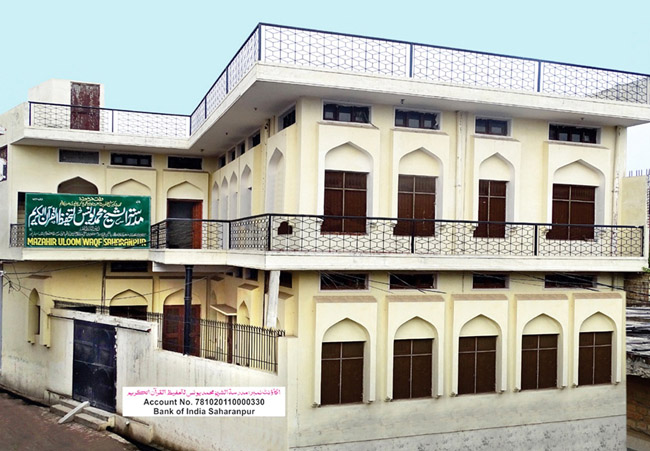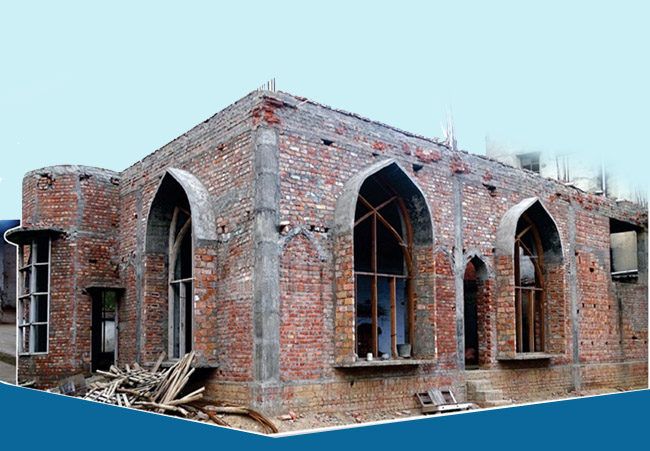Honorable Founders
Hazrat Maulana Mufti Muhammad Sa’adat Ali (rh), Faqeeh of Saharanpur
Hazrat Maulana Mufti Muhammad Sa’adat Ali (rh) was a prominent member of the group led by the great Mujahid Hazrat Maulana Sayyid Ahmad Shaheed (rh), and a teacher of Hazrat Maulana Ahmad Ali (rh), Muhaddis Saharanpuri, and Hazrat Maulana Muhammad Qasim Nanotwi (rh). He was one of the founders of Mazahir Uloom Saharanpur, a trusted companion of Hazrat Maulana Shah Muhammad Ishaq Dehlavi (rh), and one of the most distinguished personalities of his time.
Due to his special affinity for jurisprudence and fatawa, he was known as the “Faqeeh of Saharanpur.” Hazrat Shah Muhammad Ishaq Muhaddith Dehlavi (rh) held great respect for his fiqhi (legal) decisions and rulings, and was highly satisfied with them.
Seeing the deteriorating state of the Muslim community under British colonial rule, he felt it was essential to establish Deeni Madaris (religious institutions) to safeguard the community’s resources in India and to guide the new generation. As this thought solidified and circumstances compelled him to establish a madrasa, he began teaching students in his own home, providing for their accommodation and meals.
“Hazrat Maulana Shah Muhammad Asadullah (rh) writes that Hazrat Maulana Sa’adat Ali (rh) would teach certain lessons and spend the rest of his time developing the madrasa, encouraging people to contribute financially to the institution, and he himself made great efforts to raise funds.”
(Hayate Asad, Page 29, with the reference of Nizame Kanpur, dated May 1943 CE)
As the number of students increased, he expanded the madrasa by renting additional houses and utilizing the mosque in Mahalla Qazi. When the madrasa began to gain widespread acceptance and popularity, there arose a need for more teachers. Consequently, Hazrat Maulana Sakhaawat Ali (rh) was appointed as a teacher during that period.
From Arabic Madrasa to Mazahir Uloom
It is a well-known fact that the blessed process of teaching and learning had been ongoing at the residence of Hazrat Maulana Mufti Sa’adat Ali (rh) for some time, though it had not been formally named. However, due to the increasing number of students, the shifting of the madrasa to rented houses, and the increasing number of teachers, the institution was formally named "Arabi Madrasa" from the 1st of Rajab, 1283 AH (November 9, 1866 CE), and for several years, accounts were published under this name.
During this period, in 1286 AH, the founder of Mazahir Uloom, Hazrat Maulana Ahmad Ali, the Muhaddith of Saharanpuri (rh), passed away. Nevertheless, the blessed process of teaching and producing ulama that he had initiated continued. Given the increasing number of students and the circumstances, it was evident that the school could not continue indefinitely in rented premises. This realization motivated dedicated and selfless individuals like Hazrat Hafiz Fazal Haq to take action, and thus, Hafiz Sahib donated his land adjacent to the mosque in the Mahallah Chob Farosan.
During this time, Hazrat Maulana Muhammad Mazhar Nanotwi (rh) came to Mazahir Uloom. Shortly thereafter, on the wishes of the founder of Mazahir Uloom, Hazrat Maulana Ahmad Ali had to leave his job in Calcutta and return to Saharanpur. Since a proper building for Mazahir Uloom had not yet been constructed in Saharanpur, Hazrat Muhaddith Saharanpuri (rh) continued teaching at his residence for a year. On the other hand, after collecting a sum of over ten thousand rupees, he handed it over to the madrasa for the purpose of construction, and the current building, known as the "Daftare Madrasa Qadeem," was constructed with the funds he provided.
Construction of this building began in 1291 AH and was completed within a year. Upon completion, Hazrat Hafiz Fazal Haq, who had personally contributed a significant amount to the madrasa’s treasury, organized a celebratory gathering and treated all the attendees to a meal. Qasimul Uloom wa Khairat Hazrat Maulana Muhammad Qasim Nanotwi (rh) was invited to formally inaugurate the building. Not only did he attend, but he also delivered a sermon for three consecutive hours in the courtyard of the new building.
The Name of the Madrasa
Since the educational activities of Mazahir Uloom had been ongoing long before its formal establishment, the idea of creating a permanent madrasa had not even been conceived. No one could have imagined that such a small institution would one day evolve into a university, spreading its scholarly and spiritual light around the world. For this reason, the madrasa did not initially have an official name. However, in 1292 AH, when the madrasa moved from its temporary locations to its original building, the thought of giving it a proper name emerged. At that time, the renowned scholar Hazrat Maulana Muhammad Mazhar Nanotwi (rh), who was a center of knowledge and spirituality, was highly esteemed for his wisdom and virtue. It was collectively decided to name the institution "Mazahir Uloom." Interestingly, the numerical value of the letters in "Mazhar Uloom" adds up to 1291. By adding just one letter, “Alif,” the name changes to "Mazahir Uloom," which corresponds to the historical year of the madrasa's foundation, 1292 AH. As a result, Hazrat Maulana Ahmad Ali, the Muhaddith of Saharanpur (rh), proposed the name "Mazahir Uloom." This name is historically significant, as it reflects the year of the construction of the madrasa’s first building. Moreover, the name subtly honors Hazrat Maulana Muhammad Mazhar Nanotwi (rh).
Service and Dedication of the Madrasa for the Sake of Allah
Hazrat Maulana Mufti Sa’adat Ali (rh) personally took responsibility for the accommodation of the students, treating their illnesses, and providing them with clothing and other necessities. According to the records of Mazahir Uloom, he never spent a single penny from the madrasa’s funds on himself throughout his life. He was consistently concerned with the success, growth, and development of the madrasa, focusing on maintaining high educational standards and nurturing the minds of the students.
In this effort, he traveled to distant places with his special disciple, Hazrat Al-Haaj Hafiz Qamaruddin (rh), the Imam of Jame Masjid in Saharanpur, to collect donations for the madrasa. He himself also continuously provided financial aid to the madrasa.
As noted in the records of 1283 AH and 1284 AH, he generously donated numerous books to the madrasa and also contributed to its funding. His name appears in the annual list of donors in some of the madrasa's account booklets. He also undertook several trips to Meerut on behalf of the madrasa, encouraging people to become donors for the madrasa.
Few Early Students
A large number of his earliest students and learners include some personalities who became renowned muhaddis, brilliant scholars, commentators, and famous authors of their time. For example, Hazrat Maulana Ahmad Ali Saharanpuri (rh), Hazrat Hafiz Qamaruddin Sahib (rh), Hazrat Maulana Ameer Baz Khan Saharanpuri (rh), Hazrat Maulana Inayat Ilahi Saharanpuri (rh), and Hazrat Maulana Mushtaq Ahmad Anbihtwi (rh).
Jurisprudence and Fatwas
Hazrat Maulana Mufti Sa'adat Ali (rh), despite not gaining widespread fame due to his sincerity and selflessness, was undoubtedly one of the extraordinary personalities and remarkable figures of his time. He possessed complete mastery over various fields of knowledge and arts and had profound expertise in jurisprudence and issuing fatwas. His exceptional ability in jurisprudence earned him the title "Faqih Saharanpur."
Sheikhul Hadith Hazrat Maulana Muhammad Zakariya Muhajir Madani (rh) stated, “Hazrat Maulana Sa'adat Ali was among the confirmed scholars of jurisprudence.”
Hazrat Maulana Muhammad Sani Hassani Nadwi Mazahiri (rh) wrote in Hayat-e-Khaleel, "Hazrat Maulana Sa'adat Ali Saharanpuri (rh) was a highly esteemed scholar, jurist, and muhaddis. He was associated with the group of Hazrat Sayyid Ahmad Shaheed (rh). He had a comprehensive understanding of jurisprudence, principles of jurisprudence, fatwa writing, and the intricacies of legal matters. His awareness of religious and scholarly issues was notable, and this was the reason his contemporaries recognized his complete command over fatwas."
When Hazrat Maulana Shah Muhammad Ishaq Muhaddis Dehlawi (rh) migrated to Makkah, a detailed fatwa was presented to him that bore the seals and signatures of the scholars and judges there, indicating it was a collective agreement. Hazrat Maulana Shah Ishaq summoned Hazrat Mufti Sa'adat Ali (rh) to review the fatwa. Upon careful examination, Mufti Sa'adat Ali (rh) determined that the fatwa was incorrect. Upon murmurs from people, he brought relevant books to clarify the reasons for his decision, using authoritative sources to demonstrate its inaccuracies. This incident showcased his expertise, meticulous attention to detail, extensive study, and complete awareness of jurisprudential issues.
For a long time, he personally wrote responses to various scholarly, religious, and jurisprudential inquiries at the madrasa. Later, his esteemed disciple Hazrat Maulana Amir Baz Khan (rh) assisted him. A few of his scholarly fatwas are preserved at the Mufti Ilahi Bakhsh Academy in Kandhla, District Muzaffarnagar.
Nevertheless, Hazrat Mufti Sa'adat Ali (rh) was a multifaceted personality. Through his intellectual capabilities and lofty thoughts, he enlightened many with his knowledge and accomplishments. Hazrat Aqdas Maulana Naseem Ahmad Ghazi Mazahiri (rh) wrote, “Hazrat Maulana Sa'adat Ali (rh), the 'Faqeeh of Saharanpur' and founder of Mazahir Uloom Saharanpur, was blessed by Allah with grace and excellence, making him a source of beneficence. Today, his teachings continue to nourish and benefit scholars across Deoband, Saharanpur, Muradabad, Lucknow, and indeed throughout all of India, as well as in Arab lands, Europe, and beyond.”
An Interesting Incident of Devotion to Study
Respected teacher, Hazrat Maulana Atahar Hussain (rh), the esteemed scholar of literature and jurisprudence at Mazahir Uloom (Waqf) Saharanpur, narrated to me that study had become both a comfort and a necessity for him. He would remain engrossed in reading even during meals. On one occasion, while he was having his meal, he was served a dish of egg curry. Due to his deep focus on his reading, he did not even notice what the dish was. After finishing his meal, when he discovered that it was egg curry, he remarked, "Why didn't anyone tell me earlier? I would have enjoyed it more!"
The Indian Freedom Movement and Mazahir Uloom
The movement led by Hazrat Maulana Sayyid Ahmad Shaheed (rh) aimed primarily at promoting the oneness of Allah and the dissemination of the teachings of the Prophet Muhammad (saws), while defending against the injustices faced by the Muslim community. Thus, Hazrat Maulana Sa’adat Ali (rh) was not only a proponent of this blessed movement but also actively participated in it as a key figure. The well-known historian and prolific author, Hazrat Maulana Abdul Hai (rh), wrote:
کان من رہط الامام السید الشہید رحمہ اللّٰہ
He was among the group of Imam Sayyid Shaheed (rh).
In one of the writings of the esteemed Muhaddis, Hazrat Maulana Khalil Ahmad Saharanpuri (rh), it is mentioned, "He was one of the special members of the companions of Sayyid Ahmad Shaheed Barelvi." Hazrat Maulana Ashiq Ilahi Meeruthi (rh) stated, "Hazrat Maulana Sa’adat Ali Saharanpuri was a key member of the group of Hazrat Sayyid Ahmad Shaheed Barelvi (rh)."
Maulana Muhammad Yusuf Qureshi (rh) wrote in his travelogue, "Hazrat Maulana Sa’adat Ali was a member of the group of Sayyid Ahmad Imam Shaheed Barelvi (rh). He was a highly knowledgeable scholar and an expert in various fields."
Actually, along with the asceticism and spirituality, the elders of Mazahir also played a significant role in the Indian freedom movement. However, their self-sufficiency, reliance on God, sincerity, devotion, and aversion to fame kept them away from becoming widely known, or they preferred that their names remain obscure and that their religious works be publicized instead. Thus, Maulana Shamsul Haq stated,
"This Islamic seminary, which is unmatched in its simplicity, modesty, and in fulfilling its rights and duties quietly and with a balanced approach, has been a source of pride and honor for Saharanpur for over a century. This downpour of guidance has not been as loud as the achievements that have spread across India from this center of knowledge." (Monthly Magazine Al-Rashad, Vol. 1, Issue 35)
It is also an undeniable truth that the movement of the scholars of this institution was quietly active, but within that silence lay significant victories. Hazrat Maulana Sa’adat Ali (rh), the founder of Mazahir, Hazrat Maulana Muhammad Mazhar Nanotwi (rh), the head teacher, and Hazrat Maulana Rasheed Ahmad Gangohi (rh), the patron of Mazahir Uloom Saharanpur, were all remarkable figures who proudly contributed to the freedom movement.
Regarding the freedom movement, there were secret consultations, careful correspondence, monitoring the emergence of issues in various places, and keeping a close watch on gossip and intelligence regarding potential unrest. It also involved the discovery of secret conversations in the silence of the nights and the terrifying darkness. These were the struggles undertaken by the scholars of India, who played an active role in ensuring the success of the freedom movement, enduring hunger and thirst in the process. The well-known writer and essayist Aabad Shah Puri (rh) mentioned in his book, The Caravan of Sayyid Badshah, that:
"Ummeed Ali reported that the arm of one of the two messengers was injured in a fight, and Maulvi Sa’adat Ali and Maulvi Ahmad Ali of Saharanpur used to deal and exchange with Maulvi Ameerud Deen (an active worker). Thus, Ishwari Prasad obtained a search warrant, and the joint magistrate searched Maulvi Sa’adat Ali's house, finding several letters that were being inspected." (Pg. 324)
During the early days of the freedom movement, Hazrat Sayyid Ahmad Shaheed (rh) traveled throughout India, informing notable individuals about the goals and objectives of his movement. In this regard, he visited places like Deoband and Saharanpur, where he initiated a large gathering and conducted pledges.
The famous "Silken Letter Movement" was led by Sheikh-ul-Hind, Hazrat Maulana Mahmood al-Hasan Deobandi (rh). He initially consulted the scholars at Mazahir Uloom to establish and launch this movement. This indicates that it was the very seminary where the "Silken Letter Movement" first began. For details, under "Supervisors," Hazrat Maulana Ahmad Ram Puri (rh).
Hazrat Maulana Muhammad Mazhar Nanotwi (rh), the head teacher at Mazahir Uloom, the trusted person of the founder of Jamia, the beloved disciple of Haji Imdadullah Muhajir Makki (rh), and a close Khalifa of Imam Rabbani Maulana Rasheed Ahmad Gangohi (rh), not only participated in the freedom movement but also took part in the struggle for freedom (Shamli).
Please refer to the book Tareek-e-Azadi-e-Hind aur Mazahir Uloom Saharanpur for complete details about the participation of Hazrat Maulana Khalil Ahmad Maktab Saharanpuri (rh) in the freedom movement, his involvement in the Silken Letter Movement, his journey to Medina, his meetings with prominent figures there, his arrest upon his return at the Bombay harbor, the search of his belongings, his imprisonment in Nainital, and his eventual release.
Opposition to Innovations and Superstitions
Mufti Sa’adat Ali (rh) was a staunch follower of the Hanafi school of thought. He not only believed in the Qur'an, Sunnah, and Ijma (the consensus of the ummah), but also practiced them as an integrated part of his blessed life. He consistently opposed new innovations and superstitions in religion and sought to prevent their spread.
In this regard, a prominent landowner from Meerut, Mr. Ilahi Bakhsh Lal Karti, had the privilege of being in the company of Hazrat Mufti Sa’adat Ali. Under his influence, Mr. Karti renounced all forms of innovations, superstitions, and extravagant practices.
The Journey to Roorkee
Maulana Khaleel-ur-Rahman (rh) (Khalifa of Hazrat Haji Imdadullah Muhajir Makki [rh]), who was previously a Hindu and completely unaware of Islamic teachings and principles, had no knowledge of the Qur'an and Sunnah and adhered strictly to Hinduism. However, Allah, the Almighty, granted him the understanding and insight to explore and comprehend the religion. After a thorough study of Islam and its teachings, he realized that the religion of Muhammad (saws) was the true path. Consequently, he embraced Islam and was given the Islamic name Khaleel-ur-Rahman.
Embracing Islam brought him numerous difficulties. He was shackled, bound in chains, imprisoned in dark cells, kept hungry and thirsty, and subjected to various forms of torture. Despite these challenges, his resolve remained unshaken. Upon hearing about his plight, Hazrat Maulana Mufti Sa’adat Ali (rh), Hazrat Maulana Muhammad Qasim Nanotwi (rh), and Maulana Faizul Hassan Saharanpuri (rh) undertook a journey to Roorkee to meet him.
Maulana Khaleel-ur-Rahman himself wrote, "Upon hearing of my distress, the three esteemed scholars, Maulana Muhammad Qasim Nanotwi, Maulana Sa’adat Ali Saharanpuri, and Maulana Faizul Hassan Saharanpuri, came and sent for me to a secret location. I was honored to meet these great scholars, and my father even could not realize." (Anware Khaleel, p. 57)
However, Hazrat Maulana Muhammad Sa’adat Ali (rh) was a distinguished figure who had a profound spiritual connection, heartfelt bond, and deep affection for the revered personality of Hazrat Sayyid Ahmad Shaheed bin Irfan Saheb Barelwi (rh). As a result of this connection, he was immensely blessed with the inner light and spiritual bounty of Hazrat Sayyid (rh).
The Education and Guidance of Maulana Ahmad Ali (rh) and Planning of Maulana Sa’adat Ali (rh)
Hazrat Maulana Ahmad Ali (may Allah's mercy be upon him) spent 18 years engrossed in play and pigeon racing, wasting his precious youth. Hazrat Mufti Sa’adat Ali (rh) was deeply saddened by the fact that this young man, hailing from a scholarly family, was squandering his life.
One time, Mufti Sa’adat Ali devised a plan: he sent a person with a few questions to ask Ahmad Ali. When the questioner inquired about the answers, Ahmad Ali admitted his ignorance. The questioner, in a mocking tone, remarked, "You belong to such a prestigious scholarly family, and yet this is your condition?"
Hearing these words, Ahmad Ali resolved to pursue religious knowledge earnestly and set out on his quest for learning. The world knows him as a great Hadith scholar, whose students include eminent figures such as Haji Imdadullah Muhajir Makki (rh) and Maulana Rasheed Ahmad Gangohi (rh).
The Passing of Hazrat Mufti Sa’adat Ali (rh)
Nonetheless, Hazrat Maulana Mufti Sa’adat Ali (rh) was a dynamic and esteemed figure in the realms of knowledge and action, serving the religion and community. He passed away in 1286 AH, corresponding to 1869 CE, when Mazahir Uloom was just in its fourth year of foundation. The account of Mazahir Uloom noted his passing with the following words:
"Maulana Sa’adat Ali (rh) was the founder of the seminary and was constantly concerned about the madrasa, its teachers, students, and other related matters. He departed from this world, leaving the city seemingly lifeless, and the seminary faced a significant loss. May Allah grant him forgiveness and keep the seminary alive by spreading religious knowledge and reviving the Sunnah of the Prophet (saws)." (Rudāde Mazahir Uloom, 1286 AH)
Hazrat Maulana Mufti Sa’adat Ali (rh) was laid to rest in the north of Shah Noor Mosque in the Hisamuddin neighborhood.
Respected teacher, Hazrat Maulana Inamur Rahman Thanwi (rh), in 1394 AH, recorded the following date of his passing, which is inscribed on his blessed tombstone. The cost of the stone was borne by the esteemed wife of Maulana Atiq Ahmad Deobandi, the editor of Qasimul-Uloom.
حضرت الحاج مولانا سعادت علی ارجمند ٭ داشت بہرنشرعلم دیں چہ طبع دردمند
Hadrat al-Hajj Maulana Sa'adat Ali Arjumand, who had a compassionate heart for the propagation of religious knowledge.
عالم بارع فقیہ عصرمردخوش صفات ٭ ازکمالات وفضائل بودذاتش بہرہ مند
A brilliant scholar and a jurist of his time, a man of excellent character, who was enriched with noble qualities and virtues.
آں مظاہررامؤسس بود اول مہتمم ٭ آں مظاہر درسہارنپور بحرعلم وپند
He was the founder and the first rector of Mazaahir, an institution in Saharanpur, a center of knowledge and wisdom.
اومظاہر ہست مستغنی زتوصیف وثنا ٭ عالیہ وخوب خدماتش بعالم اشہرند
He is the epitome of a person who is self-sufficient from any need for praise or flattery, for his excellent services are renowned among scholars.
بد بحضرت سید احمد شہیدش ربط خاص ٭ آنکہ بود ہ دررہ حق بے خطر از ہرگزند
He had a special connection with Hadrat Sayyid Ahmad Shahid, who was fearless in the path of truth, undeterred by any danger.
ارتحالش رابکشتہ مدت بسیار بعد ٭ دوستاں چوبہر ناز ش مصر بیحد شدند
His passing left a deep sorrow for a long time, and his friends mourned him intensely, as if the city had experienced immense grief.
دریک الف وسہ صد پنج ونوہجری سنہ ٭ از پئے اصرار شاں بنوشتہ شد ایں قطعہ بند
In the year 1359 Hijri (Islamic calendar), this couplet was written in response to his earnest request, marking the dedication of this piece.
سال فوت ہجریش انعام ایں کردہ رقم ٭ افقہ مولانا سعادت در جناں بام بلند
Ina’am has written the year of his death, praying that Maulana Sa'adat is elevated to the highest place in paradise.





